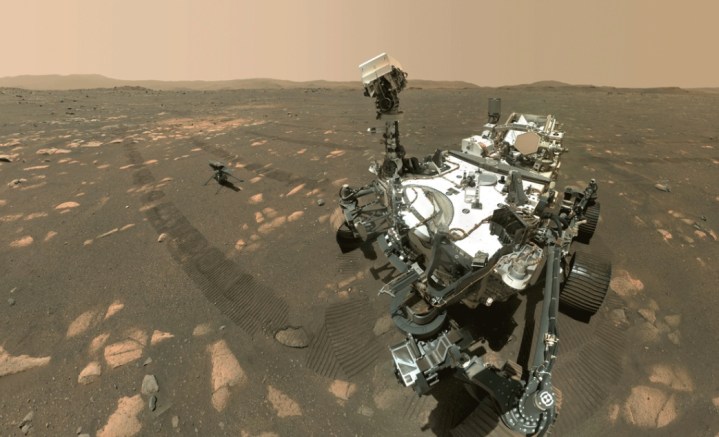
NASA’s Perseverance rover has snapped its first selfie on Mars, sharing the frame with the tiny Mars helicopter, Ingenuity.
Perseverance, which arrived on the red planet in spectacular fashion on February 18, 2021, with Ingenuity attached to its underbelly, recently deployed the helicopter to the Martian surface.
In just a few days from now, the helicopter will attempt to become the first aircraft to perform powered flight on another planet.
The selfie, captured on April 6, shows the two machines about 13 feet (3.9 meters) apart. You can also see tire marks carved into the surface by Perseverance’s six wheels.
In addition to the still frame above, the space agency also posted an animated version (below) that shows Perseverance’s SuperCam switching its glance between the helicopter and the camera taking the selfie.
Two bots, one selfie. Greetings from Jezero Crater, where I’ve taken my first selfie of the mission. I’m also watching the #MarsHelicopter Ingenuity as it gets ready for its first flight in a few days. Daring mighty things indeed.
Images: https://t.co/owLX2LaK52 pic.twitter.com/rTxDNK69rs
— NASA's Perseverance Mars Rover (@NASAPersevere) April 7, 2021
The picture was created from 62 images taken by Perseverance’s WATSON (Wide Angle Topographic Sensor for Operations and eNgineering) camera on the SHERLOC (Scanning Habitable Environments with Raman and Luminescence for Organics and Chemicals) instrument, located at the end of the rover’s long robotic arm (think of it as a high-tech selfie stick).
The images were stitched together after being beamed back to Earth. The combination of photos allowed NASA to build the final image in a way that makes it look as if the camera taking the shot is detached from the rover, with no selfie stick showing. NASA has a video showing the process in action.
“They were taken in sequence while the rover was looking at the helicopter, then again while it was looking at the WATSON camera,” NASA said, adding that its other operational Mars rover, Curiosity, which reached Mars in 2012, takes similar selfies using a camera attached to its robotic arm. You can see Curiosity selfies here and here.
Besides sending back incredible images from the faraway planet, Perseverance will also be spending its time searching for signs of ancient life during its two-year mission.
Perseverance, NASA’s most advanced rover to date, is equipped with more than 20 cameras for image capture and scientific research. Here’s what they all do.
Editors' Recommendations
- NASA video maps all 72 flights taken by Mars Ingenuity helicopter
- The NASA Mars helicopter’s work is not done, it turns out
- NASA is looking for volunteers for yearlong simulated Mars mission
- NASA reveals how Mars helicopter just kept getting better and better
- Yes, Perseverance is exploring an ancient lake bed but no, it hasn’t found signs of life (yet)


